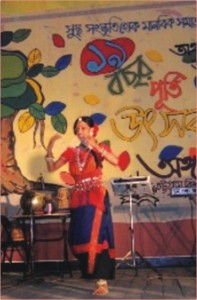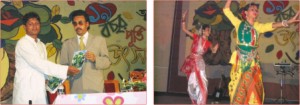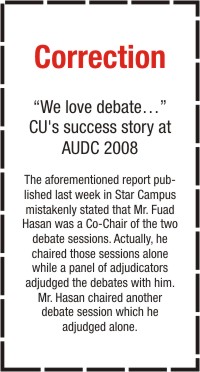Feature
Angon turns 19
Bridging the gap between
culture and humanistic efforts
Tabassum Mokhduma
 ANGON, a well known non-political cultural organization of University of Chittagong (CU) celebrated its 19th founding anniversary and paid farewell to their founding President Professor Dr. Md. Aslam Bhuiyan through a scintillating day-long event on June 7, 2008 at the auditorium of Faculty of Social Sciences, CU. ANGON, a well known non-political cultural organization of University of Chittagong (CU) celebrated its 19th founding anniversary and paid farewell to their founding President Professor Dr. Md. Aslam Bhuiyan through a scintillating day-long event on June 7, 2008 at the auditorium of Faculty of Social Sciences, CU.
The day-long programme kicked off at around 9:30 a.m. with a grand, colourful rally in the university premise which was really an affair to watch. The main occasion started after the rally where Professor Md. Zakir Hossain, Dean, Faculty of Law, CU was present as the Chief Guest. Among others, Professor Dr. Aslam Bhuiyan, Vice-Chancellor, The People's University of Bangladesh and Former Chairman, Department of Sociology, CU; Mr. Bhashkar Ranjan Shaha, founding General Secretary of Angon were persent.
Mr. Shaha in his introductory speech wished Angon for its achievement and said, “It has been a great journey for an organization like Angon, which started its flight during an unwelcoming political and social situation of early nineties.” Professor Hossain said, “It is wonderful to see an organization like Angon which from the very beginning worked boldly to espouse our culture and raised voices against all the social injustices”.
Professor Dr. Bhuiyan said, “It's my immense pleasure to be with Angon for the last nine-teen years as its President. Today I can proudly say that Angon is one of the leading non-political cultural organizations of not only CU, but also other universities around the country”.
Dr. Bhuiyan also announced that the works are underway to establish “Angon Trust” which will surely help Angon to go far.
 The event was divided into four sessions. The second session also included the tributes and farewell speeches for Dr. Bhuiyan by the present and former members of Angon. The Angon family also presented special memento to their founding president. Dr. Bhuiyan then formally welcomed and introduced Writer and Researcher Dr. Rahman Nasir Uddin, Assistant Professor, Department of Anthropology, CU as the new President of Angon. Later, Dr. Bhuiyan launched the special Angon publication to commemorate the 19th founding anniversary of this organization. The event was divided into four sessions. The second session also included the tributes and farewell speeches for Dr. Bhuiyan by the present and former members of Angon. The Angon family also presented special memento to their founding president. Dr. Bhuiyan then formally welcomed and introduced Writer and Researcher Dr. Rahman Nasir Uddin, Assistant Professor, Department of Anthropology, CU as the new President of Angon. Later, Dr. Bhuiyan launched the special Angon publication to commemorate the 19th founding anniversary of this organization.
This session concluded with the distribution of 'Uttorio' (a special type of shawl ) by the outgoing President to the members of Angon followed by photo sessions.
The cultural function started off with a chorus presentation of Angon's theme song “Amra Angon poribar” by its present members. It was a well-planned session which also included some melodious numbers like “Krishno koli ami tarei boli”, “Aguner din shesh hobe ekdin”, “Din jae kotha thake” etc. as well as recitation of eminent poet Nirmolendu Goon's poem, well-choreographed dances including a 'Chakma' dance and so on.
But the show was stolen by the brilliantly-choreographed classical dance performed by three Angon members with the song “Dhin tana…”
The Angon family termed the fourth and final session of the event as the session of “Angoner Buroburi” (Oldies of Angon). It was also a stunning session which included some good number of songs, parodies, poems and reminiscing the past by the former members of Angon.
“Shustho shongskriti hok manobik shomaj gothoner hatiar” (Let healthy culture be the weapon for establishing humanistic society), with this slogan under the brilliant leadership of Dr. Bhuiyan, Angon had started its journey on February 14, 1989 with a dedicated, culture and traditions loving group of less than 20 youths. And now after a long, eventful nineteen years, it established itself as one of the ambassadors of Bengali culture and heritage.
Amazing Facts
 * The Industrial Revolution in Europe first saw the beginning of air pollution, which gradually became a major global problem. * The Industrial Revolution in Europe first saw the beginning of air pollution, which gradually became a major global problem.
* The major air-polluting industries are iron, steel and, cement.
* Of the 35-40 million tonnes of flyash generated annually by thermal power plants in India, only 2-3 percent is productively utilized.
* The worst industrial disaster in India, occurred in 1984 in Bhopal the capital of Madhya Pradesh. A deadly chemical, methly isocyanate leaked out of the Union Carbide factory killing more than 2500 and leaving thousands sick. In fact the effects of this gas tragedy is being felt even today.
* Every year some 50million cars are added to the world's roads. Car making is now the largest manufacturing industry in the world.
* In India the number of motorized vehicles have increased from 0.2 million in 1947 to 36.3 million in 1997.
* The number of registered vehicles in Delhi is more than the sum total of registered vehicles in Mumbai, Calcutta, and Chennai.
* Major contributor to Delhi's air pollution are vehicles.
* Nearly three-fourths of India's population, which is rural, bears 84% of the burden of exposure to air pollution.
* Growing population, poverty, and inadequate access to clean fuels in rural areas have perpetuated the use of biomass, thereby condemning more than 90% of rural households and more than 35% of urban hoseholds to high levels of indoor air pollution.
(Source: Internet)
| 